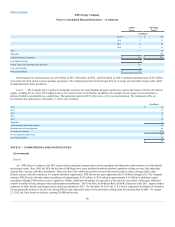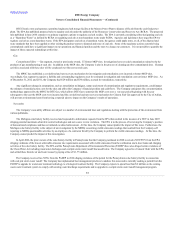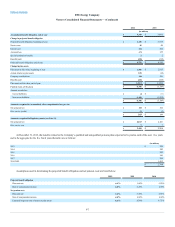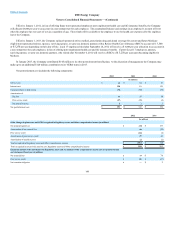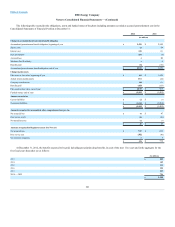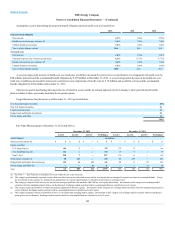DTE Energy 2012 Annual Report Download - page 100
Download and view the complete annual report
Please find page 100 of the 2012 DTE Energy annual report below. You can navigate through the pages in the report by either clicking on the pages listed below, or by using the keyword search tool below to find specific information within the annual report.
Table of Contents
The Company employs a formal process in determining the long-term rate of return for various asset classes. Management reviews historic financial
market risks and returns and long-term historic relationships between the asset classes of equities, fixed income and other assets, consistent with the widely
accepted capital market principle that asset classes with higher volatility generate a greater return over the long-term. Current market factors such as inflation,
interest rates, asset class risks and asset class returns are evaluated and considered before long-term capital market assumptions are determined. The long-term
portfolio return is also established employing a consistent formal process, with due consideration of diversification, active investment management and
rebalancing. Peer data is reviewed to check for reasonableness.
The Company employs a total return investment approach whereby a mix of equities, fixed income and other investments are used to maximize the long-
term return on plan assets consistent with prudent levels of risk, with consideration given to the liquidity needs of the plan. Risk tolerance is established
through consideration of future plan cash flows, plan funded status, and corporate financial considerations. The investment portfolio contains a diversified
blend of equity, fixed income and other investments. Furthermore, equity investments are diversified across U.S. and non-U.S. stocks, growth and value
investment styles, and large and small market capitalizations. Fixed income securities generally include corporate bonds of companies from diversified
industries, mortgage-backed securities, and U.S. Treasuries. Other assets such as private equity and hedge funds are used to enhance long-term returns while
improving portfolio diversification. Derivatives may be utilized in a risk controlled manner, to potentially increase the portfolio beyond the market value of
invested assets and/or reduce portfolio investment risk. Investment risk is measured and monitored on an ongoing basis through annual liability
measurements, periodic asset/liability studies, and quarterly investment portfolio reviews.
Target allocations for plan assets as of December 31, 2012 are listed below:
U.S. Large Cap Equity Securities
U.S. Small Cap and Mid Cap Equity Securities
Non U.S. Equity Securities
Fixed Income Securities
Hedge Funds and Similar Investments
Private Equity and Other
Fair Value Measurements at December 31, 2012 and 2011 (a):
Short-term investments (b)
$ —
$ 33
$ —
$ 33
Equity securities
—
U.S. Large Cap (c)
640
40
—
680
U.S. Small/Mid Cap (d)
159
5
—
164
Non U.S (e)
392
114
—
506
Fixed income securities (f)
88
703
—
791
Hedge Funds and Similar Investments (g)
190
58
296
544
Private Equity and Other (h)
—
—
168
168
Total
$1,469
$ 953
$ 464
$2,886
_______________________________________
(a) See Note 3 — Fair Value for a description of levels within the fair value hierarchy.
(b) This category predominantly represents certain short-term fixed income securities and money market investments that are managed in separate accounts or commingled funds. Pricing
for investments in this category are obtained from quoted prices in actively traded markets or valuations from brokers or pricing services.
(c) This category comprises both actively and not actively managed portfolios that track the S&P 500 low cost equity index funds. Investments in this category are exchange-traded
securities whereby unadjusted quote prices can be obtained. Exchange-traded securities held in a commingled fund are classified as Level 2 assets.
(d) This category represents portfolios of small and medium capitalization domestic equities. Investments in this category are exchange-traded securities whereby unadjusted quote prices
can be obtained. Exchange-traded securities held in a commingled fund are classified as Level 2 assets.
(e) This category primarily consists of portfolios of non-U.S. developed and emerging market equities. Investments in this category are exchange-traded securities whereby unadjusted
quote prices can be obtained. Exchange-traded securities held in a commingled fund are classified as Level 2 assets.
98




